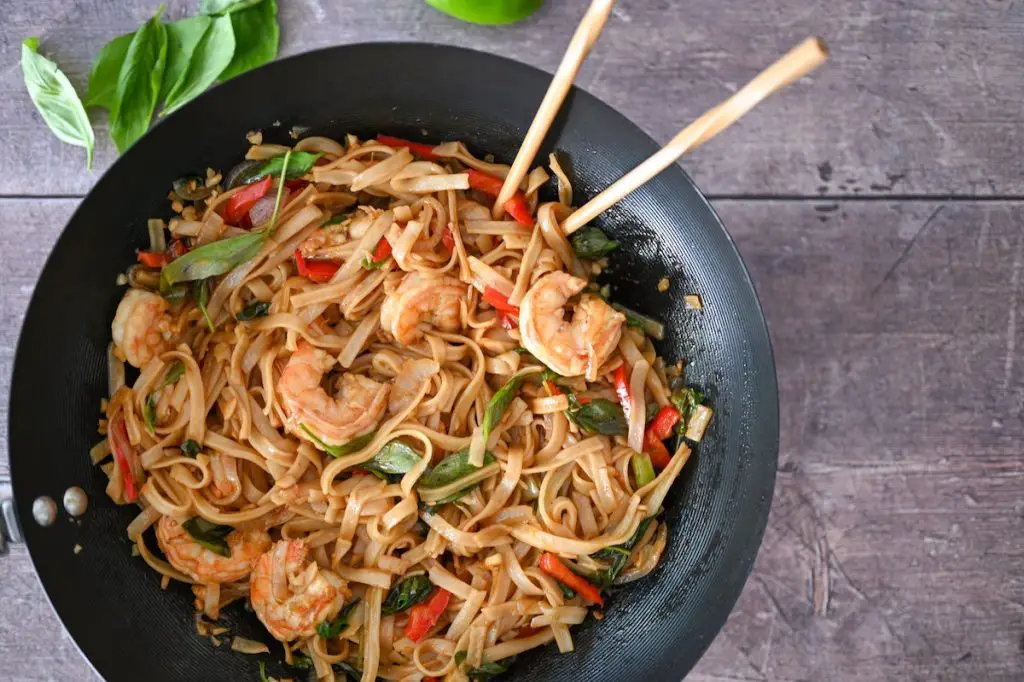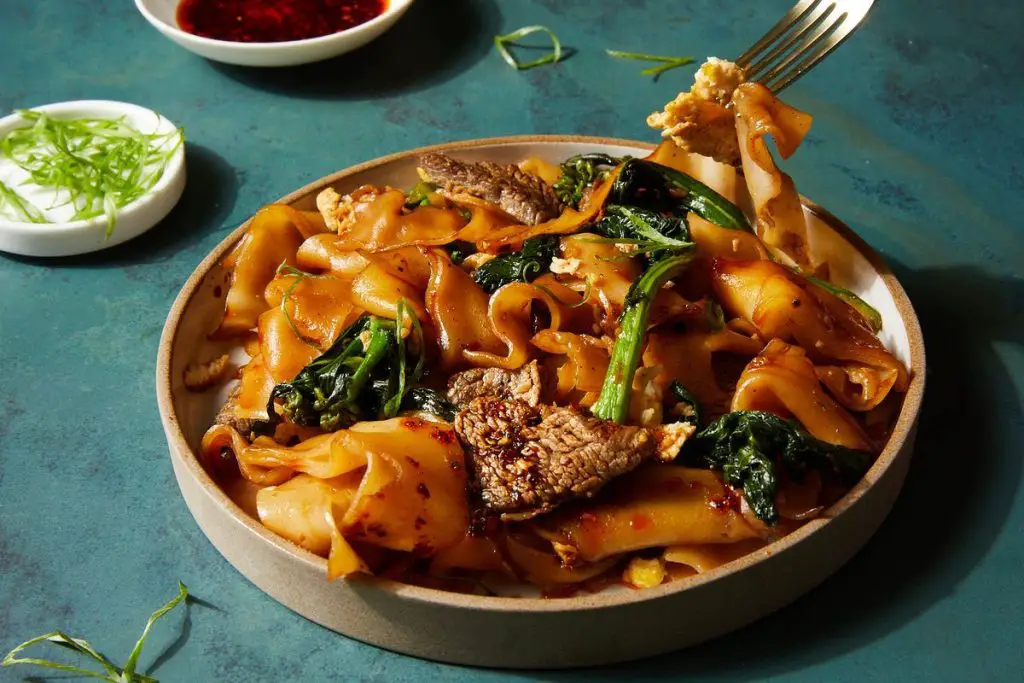Nominated-Day or Next-Day
Nominated-Day or Next-Day

The main differences between Drunken Noodles and Pad See Ew are that Drunken Noodles has some spice, while Pad See Ew has a sweeter taste. There are also some differences in the components used, which alter the taste of the meal.
If you’re a Thai food fan, you may have seen Drunken Noodles or Pad See Ew on a menu. However, you might not have eaten them before.
Both Drunken Noodles (also called Pad Kee Mao) and Pad See Ew are delicious Thai foods that might look similar at first glance, but they’re pretty different in flavor.
Check out the difference between Drunken Noodles and Pad See Ew and Pad See Ew to find out what they have in common and discover your favorite!
After we’ve learned some more details about the primary ingredients in each dish, let’s look at the areas in which they differ.
| Drunken Noodles | Pad See Ew | |
|---|---|---|
| Ingredients | Garlic, fresh chili, oyster sauce, fish sauce, soy sauce | Molasses, soy sauce, Chinese broccoli, mushrooms, egg |
| Appearance | Darker color, vegetables, protein | Large noodles, scrambled eggs, and wide noodles |
| Taste | Stronger flavor, spicy, fragrant | Sweet, mild, and mild No spice |
| Sauce | Fresh, bold, savory, and spicy | Sweet and spicy Mild and sweet |

Drunken Noodles is also known as Pad Kee Mao, which means (you probably guessed that) drunken noodles.
This dish of thin, flat noodles is a delightful blend of spicy and sweet.
Drunken Noodles originated when it was the go-to street food for those who a bit too much to drink and needed food to eat on their way back home.
Drunken Noodles are made from a combination of vegetables and the chosen protein, along with the spicy garlic sauce composed of oyster sauce, fish sauce, and soy sauce.
The dish can be enjoyed with beef, chicken, seafood, or pork or simply with a mix of veggies.
You can also top Drunken Noodles with some onions, Thai basil, and perhaps some crushed chilies for those who prefer their food with a kick!
Due to the number of spices in the Drunken Noodles, it is not too sweet.

Pad See Ew, also known as Pad Thai, is a very popular Thai dish packed with aroma and flavor. It’s not spicy; however, it packs an intense flavor that will surely delight you.
The Pad See Ew is made from broad, flat noodles, which gives the dish a soft texture.
Soy sauce and molasses help create a rich sauce, while mushroom and Chinese broccoli can add freshness and substance to the dish.
In most cases, Pad See Ew will be finished with a few scrambled eggs. It’s darker in color and is balanced between sweet and a bit savory due to the soy sauce and molasses.
Drunken Noodles are prepared with fresh chili, garlic, oyster sauce, fish sauce, fresh peppercorn, and Thai basil. These ingredients produce a distinctive flavor when cooked in oil before adding in the other ingredients.
On the other hand, the sauce used for Pad See Ew is made using of molasses, garlic, and soy sauce. The dish uses Chinese mushrooms and broccoli as well. Adding scrambled eggs provides an additional texture and taste.
While both are noodles, they still have specific appearances, so it should not be difficult to distinguish them quickly.
First, Drunken Noodles is made up of various ingredients, like proteins and vegetables, and it’s a pretty dark-colored food.
On the other hand, Pad See Ew has large, lighter-colored noodles and the inclusion of egg scrambles.
If you are eating a meal that is new, tasting is what will be the most important factor! Although both contain noodles and share some of the same elements, Drunken Noodles and Pad See Ew have distinctive flavors.
What is the flavor of Drunken Noodles? Drunken Noodles has a stronger flavor than Pad See Ew. The addition of a mix of sauces and chilies, as well as Thai basil, makes the dish more fragrant and tasty.
What is the flavor of Pad See Ew? Pad See Ew can be described as a milder, more sweet-tasting dish with no spices. The Chinese mushrooms and broccoli add an earthy, fresh taste to the noodles, while the soy sauce is a great way to counterbalance the sweetness.
The most significant similarity between Drunken Noodles and Pad See Ew is that they’re both have stir-fried noodles, usually served with protein and vegetables.
Both sauces include garlic and soy sauce; however, the other ingredients differ.
But both come with a selected protein that includes chicken, beef, pork, or seafood and a selection of vegetables.
If you’re still unsure which stir-fried noodle dish to make, let’s dive in and see if you like the sound of it!
If you’re a lover of spicy food or noodle dishes with a thick delicious sauce, Drunken Noodles is your best option. You can pick the protein you want to eat with it and enjoy the heat of the fresh chilies that are added to it.
Check out Nagi’s thai drunken noodle recipe for a fast and easy way to make this delicious Thai noodle dish.
Pad See Ew will be a better choice if you’re not in the mood for heat or excessive spices. It has a milder and sweeter taste than Drunken Noodles and has no heat. However, this doesn’t mean it isn’t tasty and delicious.
It is known that Pad See Ew noodles are usually thicker and chewier than Drunken Noodles. It could be something you like. Be aware of the fact that Pad See Ew also contains scrambled eggs. It could be something you’re interested in or don’t!
NY Times have featured a Pad See Ew recipe that is very popular and only takes one hour to prepare!
Drunken Noodles could be prepared using any kind of noodle you like; however, large rice noodles are the most popular type of noodle used. They hold the sauce well and will fill you up.
Pad See Ew can be thought to be a little healthier in comparison to Drunken Noodles, as it has fewer calories. On average, a portion from Pad See Ew has 250 calories, while Drunken Noodles contain approximately 320 calories.
Drunken Noodles, as well as Pad Thai, are two stir-fried noodle dishes. Pad Thai is sweeter and nuttier, while Drunken Noodles are flavorful and spicy. Pad Thai is also made with an underlying tamarind base, while Drunken Noodles is made with an oyster sauce base.
Leave a comment